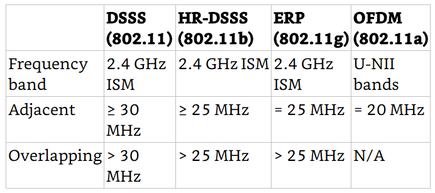Channel centers and widths (all PHYs)
. . . .
Channel centers and width (all PHYs)
2.4GHz
2.4GHz
- 11 usable channels in countries following FCC standards
- 13 usable channels in countries following ETSI standards
- 14 usuable channels in countries following Japan standards
5GHz
- Channel use is dependant on each countries regulatory standards.
- In North America there are typically more than 20 channels that can be used
- In Europe on the other hand, there are 19 channels. The regulations for Europe currently do not support the use of the UNII-3 band
- There are restrictions to how much power can be trasmitted indoor/outdoor on different UNII bands
- UNII-2 Extended bands also share the same frequency as weather radar systems and are known as DFS channels
- Figure 6.15 depicts a wide overview of all of the 5 GHz channels that
can currently be used by 802.11 transmitters. - A total of twenty-five 20MHz channels in the 5 GHz U-NII bands can be used when designing a WLAN with a channel reuse pattern.
- DSSS (legacy) channels require 30 MHz of separation between the center frequencies to be considered nonoverlapping
- HR-DSSS (802.11b) and ERP (802.11g) channels require 25 MHz of separation between the center frequencies to be considered nonoverlapping.
- 5GHz OFDM channels require 20 MHz of separation between the center frequencies to be considered nonoverlapping
Reference:
Coleman, David D.,Westcott, David A. CWNA: Certified Wireless Network Administrator Official Study Guide: Exam CWNA-106 Wiley.
Coleman, David D.,Westcott, David A. CWNA: Certified Wireless Network Administrator Official Study Guide: Exam CWNA-106 Wiley.
|
|



